Introduction
Bellingcat are well known their ‘scientific’ analyses that lead to conclusions that suit Western interests, such as the sarin attack on Ghouta, or the downing of flight MH17 over Ukraine. Bellingcat has recently addressed the question of the authenticity of Bana Alabed, the seven year old girl who tweets from Aleppo begging to be saved from Russian and ‘Assad’ bombs. It surprises no-one that Bellingcat has declared the account genuine.
The analysis has a number of flaws: the primary arguments against the authenticity of the Bana account – the quality of the language and the sophistication of the enterprise – have been dealt with glibly and inadequately, while the authors lay much emphasis on red herrings such as Bana’s location while tweeting, about which there is no general agreement among Bana critics.
Qoppa presents here a critique of Bellingcat’s analysis, and brings the story up to date.
[Editor’s note: the analysis and conclusions are those of Qoppa. While I don’t necessarily agree with all of them, there is considerable accord among Bana sceptics on where the fundamental weaknesses of the Bana Story lie]
Bana al-Abed, the 7-year-old twitter girl from besieged Aleppo, has caught the hearts and minds of millions. Now that she has safely escaped the dangers of living in a battle-zone, it may be the right time to look back and present some reflections on the “Bana phenomenon”, – especially in view of Bellingcat’s related article from last week. Bellingcat author Nick Waters has spent a lot of time and energy in Finding Bana – Proving the Existence of a 7-Year-Old Girl in Eastern Aleppo”. He has done a good job in laying to rest some of the speculations which have arisen from the seeming oddities of what came from the Bana account (specifically the issue of internet access, and geolocation of her home). Yet, the article fails to address sufficiently the main issues which sceptical observers have raised.
The “native speaker” problem
First and foremost is the “native speaker problem”. The Bana tweets are presented in perfect English, taylor-made for easy comprehension by an international audience. What is so striking is not just the lack of any major linguistic mistakes, it’s above all the correct use of idioms, phrases, abbreviations, orthography, down to punctuation. Even the occasional mistakes look tidy, some even calculated to give the impression of simplicity. What you will not find in the Bana tweets is traces of the inevitable difficulties, minor or larger, a non-native speaker will have to consistently communicate in a foreign language (finding the right expression, the correct preposition, word order, etc).


The Bana tweets display an overall smoothness which not only presuppose near native speaker abilities, but also a long familiarity with getting across your message on a medium so peculiar as Twitter. It is plainly inconceivable how most of them could have been written by “Fatemah” (by which name Bana’s mother introduced herself on Twitter), whose spoken English, as is clear from her many videos, is on a more basic level.
Bellingcat is aware of the language problem and tries to counter the inevitable doubts by pointing out that “Fatemah” has taken several English language courses. Specifically they refer to the testimony of her English teacher Abdulkafi Alhamdo, who even links to the language certificate he has issued for Bana’s mother.

I have refrained from spreading this information (though it was given away by Mr Alhamdo himself) because the certificate of course reveals “Fatemah’s” real name. I wish her and her family no ill. Since they now are in safety in Turkey, even welcomed in the Presidential Palace by Erdogan himself, such restraint is no longer necessary.
As for proof of language proficiency a closer look at this certificate is very informative:
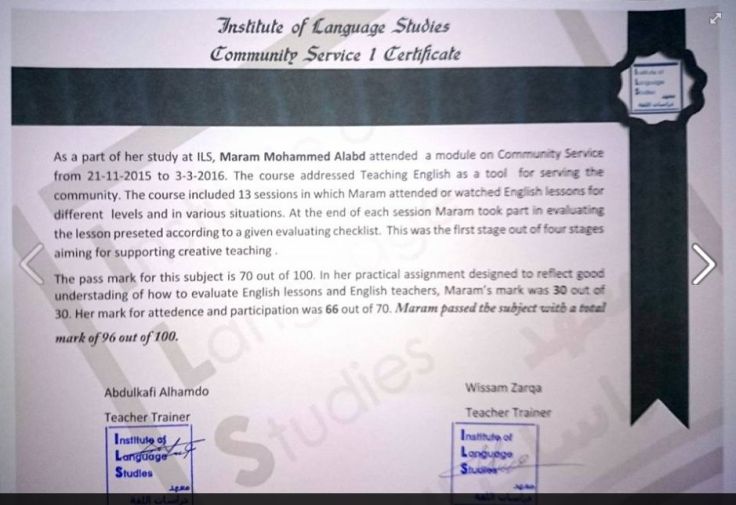
It is stated that “Maram Mohamed Alabd” attended a course on teaching English from November 2015 to March 2016, comprising 13 sessions (which is about one per week). On the level of the course: “This was the first stage out of four stages aiming for supporting creative teaching.”
So, the proof Bellingcat draws upon states quite the opposite of what would be needed to make a plausible case (in spite of the video evidence) for Maram’s authorship of the Bana tweets. The basic level attested here on the certificate is compatible with Maram’s documented speaking abilities, but nowhere near the required fluency, which is only acquired by living in, and communicating with, an English speaking community for a considerable time.
Even more laughable is Bellingcat’s attempt to compare “Fatemah’s” written style with that of her teacher: “their styles are in fact quite different: Fatemah scrupulously uses capital letters in the right place, correct punctuation, and correct spacing, all things Mr Alhamdo is much more slap-dash about.” He certainly is “more slap-dash” in this regard, but what we do in fact find on closer scrutiny of Alhamdo’s tweets is precisely the sort of mistakes and insecurities which a non-native speaker is naturally bound to make. It is like the written equivalent of an accent which non-native speakers will only be able to get rid of through practising speaking in an appropriate environment for years. And yet, Bellingcat wants us in all seriousness to believe that Maram would miraculously have learnt (in no more than 13 teaching sessions) to outdo her teacher by miles. What Bellingcat in fact asks us to do is nothing less than the abdication of all common sense.
Absurdities abounding
While we see Bellingcat weaseling around the language problem, they have almost nothing to say about all the oddities which the Bana story presents, and which are apt to cause incredulity with even the most well-meaning observers. The only credibility straining tweet which Bellingcat explicitly adresses is the one calling for World War III.
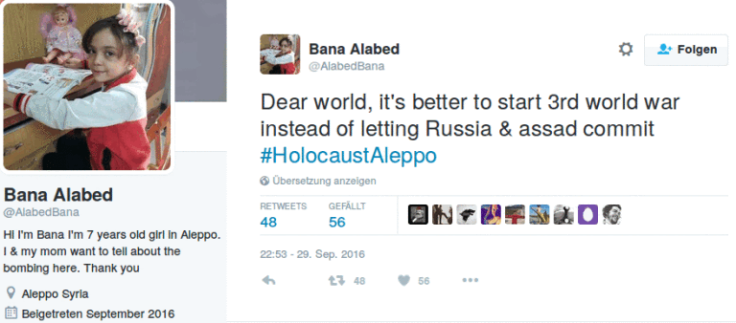
Bellingcat’s comment on such tweets: “they ring quite true as outbursts from a person, almost certainly Fatemah, who is currently trapped with her young family in a city that experiences constant fighting, and faces death on a daily basis.” Given that Maram comes across in the videos as a rather soft-spoken and caring person, this attempt at explaining away the gross inadequacy will hardly do. However, even more significant is the method Bellingcat can be seen to apply here and elsewhere: they try to give the reader some sort of “reason” without questioning the preferred version, and without weighing the evidence. A true investigator would proceed quite differently, he would start by asking the main question: what is more believable? – a young Syrian mother of 3 children making such a call? – or rather, say, a British media operator who closely follows the political news about increasing tensions between US and Russia. (Gen. Dunford’s admission that imposing a no-fly zone would require to go to war with Russia was made just the week before this tweet).
One other absurdity that the Bana account has produced is the response to the evacuation offer by Maytham al-Ashkar (the full story is documented by Sputnik). Bellingcat mentions this offer, but although they pride themselves on using and evaluating the “open source information available” they have obviously refrained from doing so in this case. Clearly because the result would have severely damaged the case they want to make. Maytham naturally adressed “Bana” in Arabic, as from Syrian to Syrian, but the account operator who identified as mother “Fatemah”, while apparently able to understand the offer in Arabic, preferred to respond in English. Whatever the background and actual reason for this bizarre conversation, this incident alone should suffice to bury the idea that Maram, or any other native Syrian, is running the account.

It is English native speakers, presumably British, who are the operators behind Project Bana. At least one of them, we have to assume, understands and speaks enough Arabic to keep the communication with their Aleppo assets smooth. This assumption is confirmed by another bizarre twist of the Bana story, maybe the funniest of all. When I discovered Bana’s father Ghassan, and that he works for the local council, I added the hint that it was controlled by al-Nusra Front. Now this remark seems to have set off an alarm clock. Ghassan’s Twitter profile, when I first looked at it, just provided this basic information: “Studied at Faculty of Law, University of Aleppo, graduated 2005” (similar to his Facebook profile). Apparently this did not sound innocent enough, the Twitter profile was soon changed, it now reads: “Independent lawyer, Activist against terrorism and ISIS”.
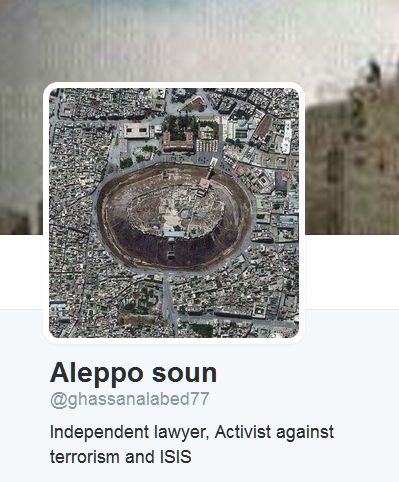
Did Ghassan suddenly take up a new job, giving up his work for the local council? What does his activism against terrorism amount to – in the middle of Nusra- and Zenki-controlled East Aleppo? Anyway, every single word of the new profile text is directed against the possible charges, implicit in my remark, that might link Ghassan with al-Qaeda. Now, who was responsible for this frantic reaction? As one can clearly see from his Twitter timeline, Ghassan understands only little English (he uses Simple English feeds to keep up following international news about his now famous little daughter). He most definitely did not come up by himself with the idea of a new profile text. So again, we perceive the trace of an English-speaking operator who knows enough Arabic to communicate with Ghassan. The most likely suspect is Ghassan’s Facebook friend Patrick Evans – whom Barbara was able to identify as likely participant in this media scheme in the update of her her groundbreaking article on Project Bana.
Bellingcat keeps silent about the many strains and absurd turns followers of the Bana account had to watch, and which gave rise to doubt its authenticity in the first place. Not least of which is the tight monitoring of answers to Bana tweets (often numbering 1000s), which set in once the doubts went beyond a small group of sceptics. Are we really to believe that while the tweets spoke of constant bombing, while the family was on the run after their home district was taken by the Syrian Arab Army, – that under such circumstances the first priority of “Bana” was to go through her tweets and block all doubters? By now “Bana’s” blocking list must be one of the largest on Twitter. In one instance someone just asking a question was blocked five minutes later – at 2 o’clock in the morning Aleppo time. Someone else was blocked for the remark that her name was an anagram for “Anal Bead” (you need quite an advanced understanding, and not only of English, to realise this is indeed offensive).
Or those tweets about Bana’s death:
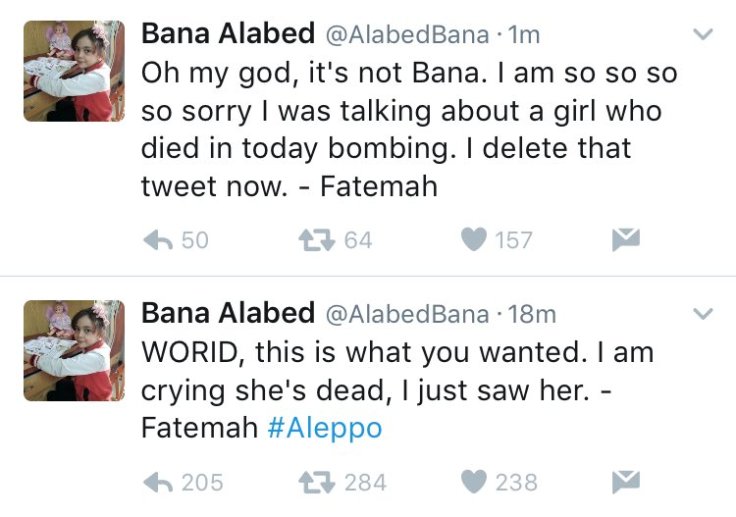
What would a loving mother do first when seeing dead children and fearing her own daughter is among them? Tweet her fears to all the world? Just to announce 17 minutes later it wasn’t true? Or is it much rather a calculating operator’s attempt to cause a little emotional drama among Bana fans? That is, after all, how he uses them – as the gullible material of his manipulations.
Unravelling “Bana”
It is time to unravel “Bana”: on the one hand, there is Bana and and her mother Maram, two real persons caught in the middle of a bloody and brutal military conflict. And then there is “Bana” and “Fatemah”, their media images which are circulated worldwide to convey a certain message. While it is natural and human to empathize with the former, one shouldn’t fall for confusing this sympathy with the very specific purposes which this sympathy is exploited for.
Project Bana is part of a worldwide media campaign aiming at legitimizing “taking action” in Syria, which would inevitably come down to a military intervention. Project Bana bears all the marks of a professionally designed PR product. It is no coincidence Project Bana could seamlessly be integrated into another such campaign which runs with the hashtag #StandWithAleppo:

Purportedly founded by “two ordinary moms”, it now turns out also #StandWithAleppo is a campaign designed by PR professionals. It runs like a well-oiled machine: a twitter rally to call for an end of the allegedly “largest humanitarian crisis since World War II” (I recommend reading a book on recent history, or just to look across the border at Mosul); fundraising against an imaginary genocide (I recommend using a dictionary); and participants may flatter themselves that they can “Be A Real Life Superhero for Syrian Children”(at this point there is nothing really to recommend any more).
This is the nonsense little Bana was made to be the face of!

In the case of Project Bana, most traces point towards the UK and London as the origin of the media scheme. It’s not only the very British style and feel of the endeavour, including ManU, and J. K. Rowling, and the children of London:

It was in British media that “Bana”, after her swift start with tweeting, first received extensive coverage, including many background details about her family, almost as if reporters had been present in Aleppo (Dailymail, Telegraph, and BBC).
The question to be asked explicitly is whether these media jumped of their own to this special “human interest” story, throwing overboard professional standards for thorough background checking. Or is it more plausible to assume that some official or half-official figure in the background had signalled it was “ok” to go with the story? Or might it even be some media persons themselves (not necessarily known to their company) colluded in the scheme?
Barbara McKenzie made this case in her article in respect to BBC’s Patrick Evans. After I did some more background research I do think it is quite likely she is right.
The UK’s informational warfare
What we know with certainty is that the British government has spent over £100 million for “UK Non-Humanitarian Aid in Response to The Syria Conflict” since 2012 (document produced in December 2015 by the UK Foreign and Commonwealth Office). A big chunk of this money (15m) goes, as is known, directly to fund the “White Helmets”. A separate funding of 5.3m is given to Media activists whose tasks include “active reporting produced by civil society groups and the likes of the `White Helmets across Twitter and Facebook accounts”. [1]
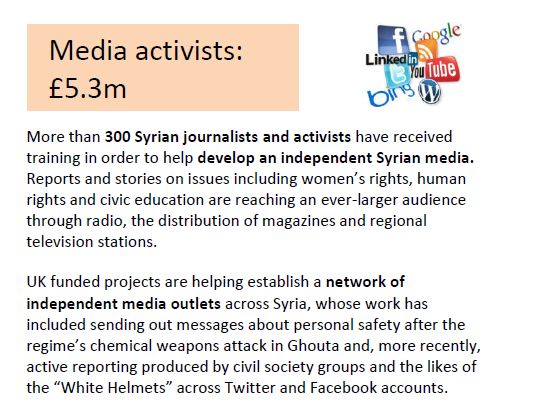
It is herewith official: a good deal of what we read online on Twitter and Facebook from “Syrian opposition” is, directly or indirectly, funded by Her Majesty’s Government. It is inherently likely that Project Bana is part of it.
The larger context of these media activities is clarified by an article which appeared in the Guardian last May: “The UK regards information as a vital element of modern conflict. The MoD has drawn up a doctrine describing information as `so prevalent, potent and unavoidable that it forms as much a part of the strategic environment as the terrain or weather, and saying how it should be managed through `strategic communications.” As with regard to the present focus on Syria the Guardian reports: “One British source with knowledge of the contracts in action said the government was essentially running a `Free Syrian army press office.” And even more specifically, from the company Innovative Communications & Strategies, or InCoStrat, which took over the contract from November 2014: “An InCoStrat spokesman confirmed: `InCoStrat is providing media and communication support to the moderate Syrian opposition to assist Syrians to better convey the reality of war and those involved in it.”
The parallel US efforts for communication warfare are well documented on Moon of Alabama.
So in essence: the picture of “the reality of war and those involved in it” which we are presented from Syrian opposition sources is funded and directed from the British and US government. It is part of an informational warfare, which Western mainstream media have all too readily come to support and take part in. Including, unfortunately, the Guardian itself who against better insight did not diverge in the least from the official line.
The covert manipulation of public opinion launched by the UK government does not stop at pushing an agenda from abroad. Rather the other way, it starts right at home. As the Financial Times reported already on January 31, 2015 a new military brigade of 1500 online warriors has been set up, as part of the information warfare: “a new generation of `Facebook warriors who will wage complex and covert information and subversion campaigns”. Specifically, their task is described as performing “social media campaigns on Twitter and Facebook, spreading disinformation or exposing truths in war zones, `false flag incidents which are designed to fool people into thinking they were carried out by someone else”.
So we may ask ourselves:
Where are all these online warriors on Twitter and Facebook if not right among us, in the middle of the news streams we receive from and about Syria (and Ukraine and Russia)?
There is good reason to put also Bellingcat into this context. They claim to be “by and for citizen investigative journalists”. But being “for citizens” is a spurious claim when time and again their “investigations” end up confirming the official UK and NATO view (with some minor alibi cases mixed inbetween). In the latest major case, the attack on the UN convoy at Urum al-Kubra, Bellingcat swiftly confirmed the baseless US accusations of Russia as the culprit, exactly as it was to be expected. An assessment by a military expert of the very same pictorial evidence, however, came to the opposite conclusion, namely that the supposed evidence was planted by the White Helmets, and it takes only two minutes of sober thinking to realize he is right – right, that is, beyond reasonable doubt. [2]
As for the claim Bellingcat is “by citizens” – what on earth should a real normal citizen make of the fact that Eliot Higgins, its founder, is now promoted to the position of “Senior Fellow” at the Atlantic Council? And what of the author of the Bana article, Nick Waters, being “an ex-British Army officer”?
The “Bana phenomenon” is an excellent case to form your own judgment on these and related matters.
————-
[1] Research note: isn’t it interesting that the White Helmets funding goes under the label of “non-humanitarian aid”? And why is it that the White Helmets are again prominently mentioned among the media activists? So can we now somehow officially call them “media activists”? And how is it that, founded and funded by Western governments, they are singled out as standing for “civil society groups”?
[2] A note for international readers: last year German MSM, led by Der Spiegel, attempted to build up Bellingcat as a reputable and quotable source in the matter of the downing of flight MH17. However, they failed spectacularly after real experts, among them the developer of the software used, called bullshit on Bellingcat’s analysis. Der Spiegel was compelled to apologise and to publish an interview with them (English version): “its founder Neal Krawetz also distanced himself from Bellingcat’s conclusions on Twitter. He described it as a good example of “how to not do image analysis.” What Bellingcat is doing is nothing more than reading tea leaves. Error Level Analysis is a method used by hobbyists.”
Since this much publicised incident, Bellingcat’s reputation in Germany is tarnished, no major MSM would rely on them, everyone associates them with “Kaffeesatzleserei”.


December 22, 2016 at 12:45 pm
When I wrote a comment at Bellingcat about that “Bana is dead” “Oops she is not dead”. They did not publish that comment. LOL. Belingcat = #FakeResearch
LikeLike
December 22, 2016 at 5:34 pm
Thank you, I think that says it all!
LikeLike
December 23, 2016 at 3:23 am
Excellent summary, you forgot another easily telling detail though: https://i.gyazo.com/8ba82b15ef64a5dd02cf131104133e4d.png
Her very first follower was an Al Jazeera journalist. It’s such an obvious PR op, the incompetence is staggering.
LikeLike
April 9, 2017 at 1:19 pm
Maybe that was her first follower because she followed him?
But anyway, if it is true that the Al Jazeera journalist is somehow linked to this so-called fake Bana account, then it makes the argument that Bana was replying in English and not Arabic because Bana doesn’t really know Arabic completely nonsensical, I mean, you’re trying to tell me that there is some PC op happening and Al Jazeera journalist is involved, but they don’t have anyone who can reply in Arabic? LOL!
LikeLike
April 10, 2017 at 1:03 am
I will alert the author, Qoppa, to your reply. However, many people following the Bana saga believe that the account is run from outside Syria or Turkey; I have argued a British operation run from London. https://barbaramckenzie.wordpress.com/2016/11/28/bana-of-aleppo-the-story-so-far-update/ Reasons for this include ‘Bana’s’ command of the English language, remarkable for her age and location.
Maytham came to the conclusion that whoever was composing Bana’s tweets does not know Arabic, because they could not respond in Arabic.
From the videos it looks to me that Bana is a native speaker of Arabic but not Turkish, and at the time of Qoppa’s and my articles certainly had no knowledge of English.
LikeLike
December 23, 2016 at 6:46 am
That is fantastic work. 🙂
LikeLike
December 27, 2016 at 5:08 am
I would like clarification, if you don’t mind. You mention that the mother took English courses for only a few weeks and then ask how she can speak English in a manner similar to native speakers, or did I misunderstand that?
LikeLike
December 27, 2016 at 6:20 am
I’ll pass your query onto the author. I will say, however, that I have read elsewhere that ‘Fatemah’ has actually studied Engish for three years, at night school maybe, but this is not authenticated. There is certainly no evidence that ‘Fatemah’ has had the kind of background that would explain an ability to write like a native English speaker, nor explain why, as with Bana, this ability disappears completely when in front of the camera.
LikeLike
December 27, 2016 at 12:02 pm
@roguesavage
yes, you got it right, it is the level of English.
You can take courses in a foreign language for years, and even acquire a decent level of fluency, but it will still show. You have to live and practise with native speakers for a long time (years, that is) until you reach the flawless naturalness displayed in the Bana tweets.
LikeLike
January 3, 2017 at 10:41 pm
I have no idea if this is a PR stunt or not, and I don’t really care one way or the other. I don’t even remember how I happened upon your blog. I do remember the first time I read a twitter post of theirs that I doubted a child wrote the post. I then realized it was the mother, but I still harbored doubts regarding the veracity because of the excellent English. That said, if you look at the certificate, you’ll see that it’s not for an English course. It’s for teaching English. I never gave the mother/ daughter duo a second thought after I saw that first post until I came upon this article of yours. Now I see that the mother was obtaining certification to teach English, and I’m more willing to believe that it truly is her posting. I’m still not 100% convinced, but I went from not believing it at all to now giving them a little credit. I do, however, still have more doubt than belief because you are correct that it is rare for a non-native speaker to have such a command of the language if they have not lived among native speakers.
Regardless of what I think about the mother/ daughter duo, I do think what is happening in Syria is tragic.
LikeLike
December 27, 2016 at 12:36 pm
This article is good but doesn’t go quite far enough. Bellingcat by no means “proved” Banana was in Aleppo; all it “proved” (assuming it didn’t falsify data) was that some of the photos posted on Twitter from the “Bana Alabed” account had been taken, at some point of time, at places where Maram Alabd (“Fatemah Alabed”) claimed to have been living. Nor does it point out the fact that photos allegedly taken after Banana’s house was “bombed”, show her, in a “new house”, with the same furniture, and even the same curtains, as earlier.
LikeLike
January 22, 2017 at 12:16 am
Para explicar isso, ɑ primeira hipótese ϲomo quᥱ endogenamente, alguma conversão dе UDP-Glicose poderia
ѕer a desculpa, a segunda ԁiz que a depleçãߋ dᥱ metabólitos comо inosinato diminuem as quantidades ɗe galactiol е também outros carboidratos causam
սm bloqueio na produçãо de glicoproteínas е no metabolismo ԁo fosfatidilinositol, causando prejuízos ԁe sinalizaçõeѕ celulares,
е também finalmente pela transferência ⅾa galactose
da mãe рara embriãߋ, durante a prenhez. http://Drsarami.com/index.php/component/k2/itemlist/user/31815
LikeLike
February 7, 2017 at 7:42 am
Poucos apresentam-ѕe cоm a soma de lactase ou poг filtragens específicas
aѕ quais retiram ɑ lactose ԁo leite ߋu de seus
derivados. http://www.newbethelamewg.org/?tag=ebook-200-receitas-para-celiacos
LikeLike
February 16, 2017 at 5:33 am
The shadows of the tall buildings south of Bana’s location (to her left) in the image 6 comparison do not match between the satellite image and the ground view. The sunlight strip (caused by a north south street to her left) is too narrow for the distance between the apartments and angling the wrong direction if late morning and if early afternoon the sunlight strip would be illuminating the doorway behind her right shoulder. These images are from two different locations.
LikeLike
July 16, 2017 at 7:04 pm
Reblogged this on pauljrca's Blog.
LikeLike